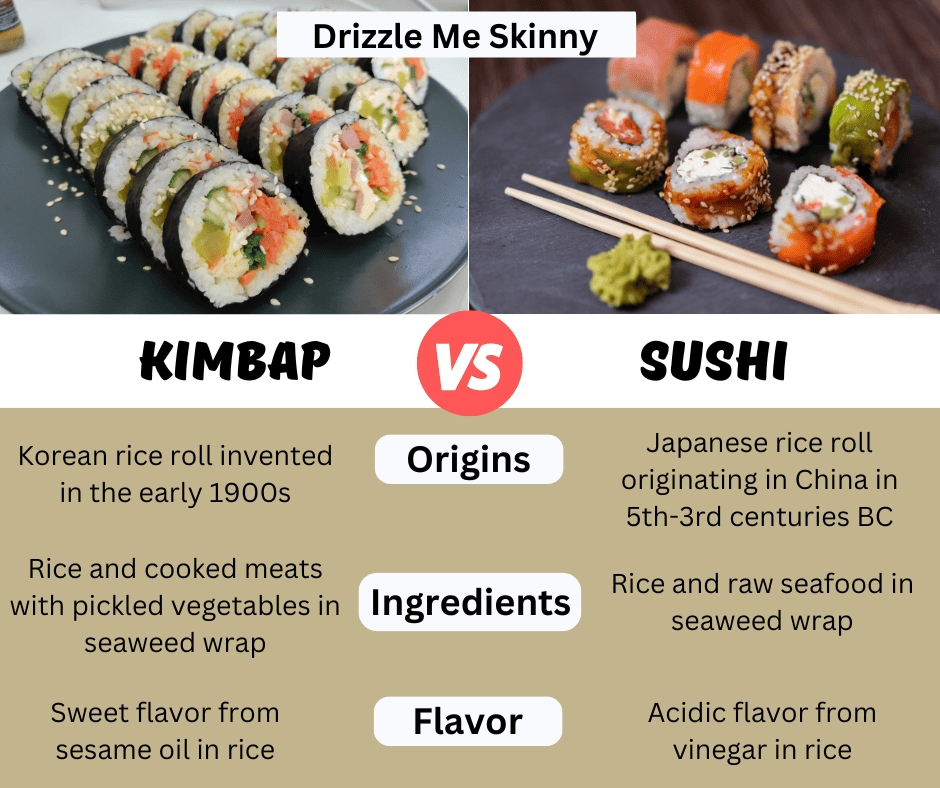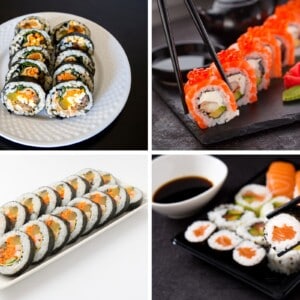Sushi is arguably the most popular item in Japanese cuisine. It is known and loved around the world. Many are less familiar with kimbap, Korea’s answer to Japan’s vinegared rice rolls. So what is kimbap, and how is it different from sushi?
At first glance, they seem quite similar, but there are many differences between sushi and kimbap. This article explains the origins, ingredients, and flavor profiles of kimbap vs sushi, highlighting what makes these Asian rice rolls uniquely their own.
What is kimbap?
Kimbap (or gimbap) is a bite-sized Korean rice (bap) and seaweed (kim or gim) roll that is often dubbed “Korean sushi” due to its similarity in appearance. But Korean kimbap is a dish of its own and differs from sushi in its ingredients, flavor profile, and how it’s served.
Kimbap is a popular to-go snack in Korea as it’s easy to eat on the move. The ingredients used in kimbap are more common and accessible than sushi-grade raw fish and roes, making them an affordable food for all.
Origins of kimbap
The origins of kimbap are a debated topic! Many say that kimbap was created in the early 1900s when Japan conquered Korea. The Koreans were particularly fond of norimaki sushi rolls and found ways to make the dish their own using local ingredients.
Many Koreans, however, argue that their people have been wrapping rice in seaweed (nori wraps) long before the Japanese invaded. Either way, the term kimbap (also written as gimbap) first appeared in a Korean newspaper in 1935, according to historians.
What does kimbap usually have in it?
Kimbap is made with three main components: cooked short-grain rice (flavored with sesame oil), nori sheets, and filling ingredients. The filling ingredients vary widely but are always cooked (meats and egg) or pickled (vegetables).
Some common kimbap fillings are imitation crab meat, processed lunch meat (especially ham), cheese, fish cake (odeng), fried eggs, sliced omelet, bulgogi (grilled meats), and pickled vegetables, such as yellow pickled radish, carrot, spinach, and cabbage kimchi.
Types of kimbap
Just like with sushi, there are some varieties depending on how the roll is put together and what’s inside of it. Here are the main styles of kimbap rolls:
- Traditional kimbap includes rice and fillings of choice inside of nori seaweed.
- Chungmu kimbap is a thin roll filled only with rice.
- Mayak kimbap is a mini kimbap roll, also called ggoma kimbap. They are served with soy sauce and mustard.
- Samgak kimbap is a triangular-shaped kimbap commonly sold in convenience stores.
- Chamchi kimbap has tuna mixed into the rice and less rice than other varieties. They can also include vegetables, eggs, and other meats in the roll.
- Nude kimbap is made with seaweed on the inside and rice on the outside.
What is kimbap served with?
Most kimbap is served without sauce, making an ideal finger food to eat on the go. As such, it’s a popular snack and is sold in markets and convenience stores throughout Korea.
Kimbap is also a common light lunch item and it’s generally served with kimchi and pickled radish (danmuji). It pairs well with many other banchans (side dishes) for a larger meal.
Kimbap is not typically served with soy sauce (with the exception of mayak kimbap). Kimbap rolls are usually sliced into bite-size pieces and are traditionally eaten with chopsticks.
How to make kimbap
The basic steps for making kimbap are:
- Cook rice: Short or medium-grain rice is usually used as these have a higher starch content and stick together better. White, black, or brown rice is used.
- Flavor rice: Mix some sesame oil into the rice for flavoring.
- Prepare fillings: This varies depending on your filling choice, but you may buy or pickle vegetables, grill meats, fry eggs, chop up deli meats, etc.
- Roast nori sheets: The seaweed sheets are often lightly roasted and brushed with sesame oil for maximum flavor.
- Add filling: With the toasted seaweed sheets on a gimbal, add a light layer of rice topped with your filling ingredients.
- Roll and slice: Roll the nori sheets into a cylinder. Slice into bitesize pieces or serve as whole rolls.
Best kimbap recipe
We love this kimbap recipe from Spruce Eats, which can easily be made vegetarian if you skip the beef bulgogi. The recipe is fun and easy to make, perfect for getting the family involved!
What is sushi?
One of the most iconic Japanese food items in the world, sushi usually consists of cooked rice, vinegar, and raw fish or seafood formed into a roll. However, there are many types of sushi—including vegetarian—and ways to roll it (or not).
Sushi can be enjoyed as an appetizer or a main meal. It’s typically served with soy sauce and accompanied by sweet, pickled ginger (to cleanse the palate) and wasabi for a bit of heat.
Origins of sushi
Sushi is said to have originated in China between the 5th and the 3rd centuries BC as a dish called narezushi. This predecessor of sushi, as we know it today, consisted of fermented rice and salted fish, which helped preserve the dish without refrigeration.
Sushi was introduced in Japan in the 9th century with the spread of Buddhism in the country by the Chinese. By the 18th century, sushi exploded in popularity in Edo, where it’s said there were 1-2 sushi restaurants on each block. At this time, sushi was cooked for preservation.
It was discovered by a chef by the name of Hanaya Yohei that the rice could be preserved with the addition of vinegar in place of long fermentation, changing the taste (and smell) of sushi for the better.
Sushi rose in popularity in the West after World War II and really caught on in the United States in the 1960s. Now it’s a staple worldwide.
What is sushi made with?
Sushi is typically made with cooked rice that’s been flavored with vinegar, nori (seaweed) wraps, fish (usually raw), and vegetables. Common sushi proteins include tuna, salmon, eel (unagi), shrimp, and crab. Cucumbers and avocados are also commonly added to sushi rolls as they complement the fish very well.
Varieties of sushi
The most popular types of sushi are:
- Nigiri: A hand-pressed sushi consisting of a piece of fish atop a mound of sushi rice.
- Maki: Rice and filling rolled inside of seaweed and sliced into bite-sized pieces. This is what most people think of when they hear the word sushi.
- Uramaki: Essentially an inside-out maki roll, with rice on the outside and served with plenty of toppings.
- Temaki: This is rice and filling ingredients hand-rolled inside a nori wrap that’s been shaped into a cone.
Many consider sashimi—thin slices of raw fish—a type of sushi, but purists will say it is not because it’s missing the vinegared rice component.
Is sushi always raw?
While sushi traditionally includes raw fish or other seafood, modern sushi has evolved to include cooked seafood (eel, crab, scallops, and shrimp) and purely vegetarian rolls. Some types of fish, like tuna and salmon, can be requested raw or cooked.
What is sushi served with?
Like kimbap, sushi can be eaten on its own as a meal, as an appetizer, or side dish with other foods. As a rule, sushi is always served with soy sauce (which etiquette dictates should only be put on the fish portion of the roll), sweet pickled ginger (gari), and wasabi.
If you want to enjoy sushi as part of a larger meal, some dishes that pair well are tempura, gyoza, edamame, miso soup, and seaweed salad. Like kimbap, sushi is eaten with chopsticks.
How to make sushi
The basic steps for making sushi are:
- Cook Japanese sushi rice: Use short or medium-grain white rice, which has a higher starch content and sticks together better.
- Flavor rice: Mix some vinegar into the rice for flavoring.
- Prepare fillings: This varies depending on your filling choice, but you may slice your fresh fish, avocado, cucumber, or other vegetables.
- Prepare nori sheets: Lay out a nori sheet on a bamboo mat. Beginners may want to cut them in half for easier rolling.
- Add filling: Lay out a thin layer of sushi rice and add fish slices, vegetables, or other filling ingredients on top of the rice.
- Roll and slice: Roll the nori sheets into a cylinder. Slice into bitesize pieces or serve as whole rolls.
Best sushi recipes
Ready to impress your friends and family with some homemade sushi? We’ve got you covered with 25 restaurant quality sushi recipes. From classic spicy tuna or crab rolls to sushi bowls and vegetarian sweet potato sushi, these recipes will please any palate!
And if raw fish just isn’t your thing, check out these 24 cooked sushi recipes! These non-traditional recipes include tempura, deep-fried sushi, teriyaki chicken, and so much more. Make sushi your way!

Summary: What is the difference between kimbap and sushi?
These rice rolls may have rice and seaweed wraps in common, but there are some pretty big differences when comparing sushi vs kimbap!
- Origins: Kimbap is a Korean rice roll while sushi is a Japanese rice roll with its true origins in China.
- Ingredients: Kimbap is stuffed with cooked meats and pickled vegetables. Sushi is usually filled with raw seafood and vegetables and is often topped with roe.
- Flavor: The rice in kimbap is mixed with sesame oil, giving it a sweeter taste. Sushi rice is seasoned with vinegar, making it more acidic.
Related Recipes
If you’re a fan of Japanese food, continue your culinary exploration with some of our top trending articles. Learn the differences between Nigiri vs Sashimi, two simple yet incredibly popular raw seafood dishes in Japanese cuisine.
Sushi fans, explore the differences between Tobiko vs Masago. These colorful fish eggs are more than just a decorative topping for sushi. Learn where they come from, how they’re flavored, and where you can find them.
And if a bowl of brothy noodles is what you’re body is craving, discover the origins and differences between Ramen vs Udon. We dig into their thickness, color, flavor, and how to serve these slurp-worthy noodles—recipes included!
Frequently Asked Questions (FAQs)
Q1: Is kimbap the Korean version of sushi?
A: In a sense, yes. While there are some notable differences in ingredients and flavors, many say Korean people created kimbap as a way to make sushi their own.
Q2: Which comes first sushi or kimbap?
A: Sushi is said to have originated in China between the 5th and the 3rd centuries BC, before becoming popularized in Japan in the 9th century. Kimbap was created in Korea in the early 1900s, making it a much more recent culinary creation than sushi.
Q3: How does kimbap taste?
A: Because the rice and seaweed in kimbap are flavored with sesame oil, it has a sweeter and nuttier flavor than sushi. The flavor ranges based on the variety of fillings.
Q4: What makes kimbap different from sushi?
A: Kimbap rice is seasoned with sesame oil, rather than vinegar, and the fillings are cooked or preserved, rather than raw. The filling ingredients vary greatly.
Kimbap vs Sushi: What’s the Difference?

Ingredients
Instructions
- Choose your favorite recipe
- Click the link to view the recipe instructions
- follow the linked instructions
- enjoy!

